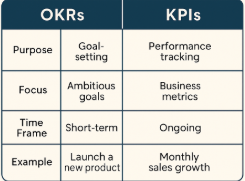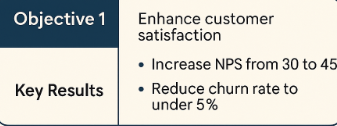As a small business owner, you’re likely juggling several tasks at once. Deciding whether to focus on OKRs or KPIs can feel like navigating through a maze.

Are you tracking progress in your business but not seeing the results you hoped for? This is a question that keeps many business owners up at night. Achieving the results you aim for requires more than just keeping an eye on numbers. It involves understanding what those numbers mean, and more importantly, how they align with your overall objectives.
OKRs can feel like navigating through a maze. Both OKRs (Objectives and Key Results) and KPIs (Key Performance Indicators) have their place. The question is when and how should each be utilized for your business strategy?
This article is here to clear the fog. I’ll guide you through understanding the difference between OKRs and KPIs. We’ll explore when to introduce each one into your business operations, and how they can work together to push you closer to success.
By the end of this, the ‘either-or’ debate won’t seem so daunting and you’ll have a clear understanding of how both can be tools in your arsenal for achieving lasting business growth.
Understanding OKRs | Ambitious Goal-Setting
Objectives and Key Results are a goal-setting framework that helps you aim higher and achieve more ambitious outcomes. They’re all about the big picture. At their core, OKRs revolve around two components: Objectives and Key Results.
Objectives are your big, ambitious goals. Think of them as your mission, phrased simply: what do you want to achieve? An objective should inspire and be visionary, like building a stronger online presence for your business. They’re about setting sights on a horizon that pushes you further than where you are now.
On the other hand, Key Results lay out the path to achieving those objectives. They’re clear, measurable outcomes, marking your progress toward reaching the objective. For example, if your objective is to build a stronger online presence, your key results might include publishing 12 blog posts in a quarter or growing your email subscriber list to 1,000.
The purpose of using OKRs is to:
- Sharpen focus.
- Enhance alignment.
- And ensure measurable progress in the direction of your overarching vision. each step.
They force you to take stock of what truly matters and align your everyday activities with your long-term aspirations. This alignment leads to a clearer path forward, where everyone knows what success looks like.
In practice, imagine you’re a solopreneur hoping to ramp up your digital footprint. Your objective could revolve around this new, aspirational target for online engagement. With key results spelling out specific milestones, like blog posts or subscriber count, you create a roadmap that’s not just navigable but motivating and achievable.

Exploring KPIs | Monitoring Business Performance
Key Performance Indicators are distinct from OKRs in that they focus more on tracking ongoing business performance rather than setting new lofty goals. KPIs help you monitor the heartbeat of your business through measurable metrics that reflect how well your operations are performing.
Furthermore, KPIs are tied closely to business-as-usual activities. They’re not about dreaming big but making sure everything’s running smoothly. They help you keep a finger on the pulse of daily operations and also alert you to any potential issues before they become critical.
These indicators are focused on aspects like:
- Operational health.
- Identifying trends.
- And ensuring consistency in your processes.
Think of them as a dashboard—offering data insights at a glance. For instance, a solopreneur might track the website bounce rate to gauge user engagement, monitor email open rates for campaign effectiveness, or review conversion rates to understand sales performance.
KPIs are invaluable for tracking whether you’re hitting your expected business milestones and maintaining the health of your operations. They’re great for spotting patterns, helping you react to any sudden shifts in performance before they escalate into larger issues.
To give an example, tracking the bounce rates on your site could show issues with user engagement. However, monitoring customer retention rates might prime you for adjusting marketing strategies. Thus, KPIs offer a signpost, letting you know if your business train is still on track or if a course correction might be needed.
Harmonizing OKRs and KPIs | Crafting a Cohesive Strategy
OKRs and KPIs aren’t competitors. On the contrary, they’re companions when it comes to steering your business towards success. They serve distinct purposes, but when used together, they create a well-rounded strategy for growth and operational health.
The key difference lies in their focus. OKRs are about ambitious goal-setting. They’re perfect for when you’re venturing into new territories or pivoting strategies. They encourage you to stretch beyond the comfort zone with a view to achieving something greater.
KPIs, on the other hand, continually measure current performance and operational metrics. This makes them ideal for ensuring your business remains healthy and moving steadily forward. They’re like the maintenance checks your car needs to keep running smoothly.
Figuring out when to use each starts with understanding your immediate needs. If you’re setting out to achieve bold new goals, focusing on OKRs might be your best bet. But, if you’re looking to monitor your everyday operations effectively, KPIs will serve you well.
Many businesses find the greatest benefit by employing both strategies simultaneously. While OKRs push innovation and growth, KPIs keep tabs on performance and flag potential problem areas early. This approach ensures your day-to-day actions are aligned with your larger aspirations.
For solopreneurs, the strategy doesn’t have to be overwhelming. Start with one objective tied to two or three key results and choose a handful of KPIs that highlight operational essentials. Use tools like Google Sheets or Trello to track progress easily without adding unnecessary complexity.
Remember, the harmony of OKRs and KPIs relies on regularly revisiting your goals and measurements. Adjust as needed based on outcomes to ensure continued alignment with your broader business vision.
Conclusion | Choosing the Right Tool for the Right Purpose
As a solopreneur or small business owner, knowing when to use OKRs and when to rely on KPIs can make the difference between spinning your wheels and making meaningful progress.
Let’s revisit the key takeaways:
- OKRs are best when you’re setting ambitious goals, launching something new, or aligning your focus with your long-term vision.
- KPIs, on the other hand, are your performance compass—keeping you grounded, informed, and aware of how your business is running day to day.
You don’t have to choose one or the other. In fact, using OKRs and KPIs together creates a balanced system:
- You set bold goals with OKRs and monitor your ongoing health with KPIs.
- Think of OKRs as your engine for growth and KPIs as your dashboard for control.
Take a moment to reflect: Are you setting goals you can measure? Are you tracking the numbers that really matter? If you’re ready to bring focus to your vision and discipline to your progress, you’re already ahead of the curve.
Which approach are you currently using—or planning to try? Drop your thoughts or questions in the comments below. I’d love to hear how you’re using OKRs, KPIs, or both to move your business forward!
Veron | Entrepreneur | The Way 4Word Enterprises | Premium Member, Wealthy Affiliate